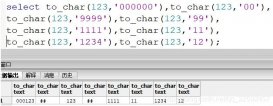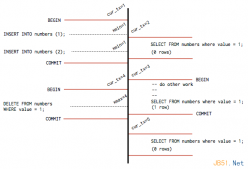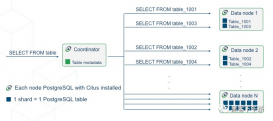无序uuid对数据库的影响
由于最近在做超大表的性能测试,在该过程中发现了无序uuid做主键对表插入性能有一定影响。结合实际情况发现当表的数据量越大,对表插入性能的影响也就越大。
测试环境
PostgreSQL创建插入脚本,测试各种情况的tps。
数据库版本:PostgreSQL 10.4 (ArteryBase 5.0.0, Thunisoft)
操作系统配置:CentOS Linux release 7 ,32GB内存,8 cpu
测试参数:pgbench -M prepared -r -n -j 8 -c 8 -T 60 -f /opt/thunisoft/pgbench_uuid_v4.sql -U sa pgbenchdb
空表,1000w数据,5000w数据,一亿数据的各种主键测试。
测试无序的uuid,有序的uuid,序列,有普通btree,有唯一索引和没有主键的情况
测试
1.创建表
|
1
2
3
4
5
6
7
8
9
10
11
|
--无序的uuidpgbenchdb=# create table test_uuid_v4(id char(32) primary key);CREATE TABLE--有序的uuidpgbenchdb=# create table test_time_nextval(id char(32) primary key);CREATE TABLE--递增序列pgbenchdb=# create table test_seq_bigint(id int8 primary key);CREATE TABLE--创建序列 create sequence test_seq start with 1 ; |
2.测试脚本
|
1
2
3
4
5
6
7
8
9
|
--测试无序uuid脚本vi pgbench_uuid_v4.sqlinsert into test_uuid_v4 (id) values (replace(uuid_generate_v4()::text,'-',''));--测试有序uuid脚本vi pgbench_time_nextval.sqlinsert into test_time_nextval (id) values (replace(uuid_time_nextval()::text,'-',''));--测试序列脚本vi pgbench_seq_bigint.sqlinsert into test_seq_bigint (id) values (nextval('test_seq'::regclass)); |
无序uuid,无数据情况
|
1
2
3
4
5
6
7
8
9
10
11
12
13
14
15
16
17
18
19
20
21
22
23
24
25
26
|
磁盘使用情况avg-cpu: %user %nice %system %iowait %steal %idle 0.76 0.00 0.38 4.67 0.00 94.19Device: rrqm/s wrqm/s r/s w/s rkB/s wkB/s avgrq-sz avgqu-sz await r_await w_await svctm %utilsdb 0.00 0.00 0.00 0.00 0.00 0.00 0.00 0.00 0.00 0.00 0.00 0.00 0.00sda 0.00 0.00 0.00 96.00 0.00 2048.00 42.67 1.02 10.67 0.00 10.67 10.33 99.20dm-0 0.00 0.00 0.00 96.00 0.00 2048.00 42.67 1.02 10.66 0.00 10.66 10.32 99.10dm-1 0.00 0.00 0.00 0.00 0.00 0.00 0.00 0.00 0.00 0.00 0.00 0.00 0.00dm-2 0.00 0.00 0.00 0.00 0.00 0.00 0.00 0.00 0.00 0.00 0.00 0.00 0.00tps:[thunisoft@localhost thunisoft]$ pgbench -M prepared -r -n -j 8 -c 8 -T 60 -f /opt/thunisoft/pgbench_uuid_v4.sql -U sa pgbenchdb transaction type: /opt/thunisoft/pgbench_uuid_v4.sqlscaling factor: 1query mode: preparednumber of clients: 8number of threads: 8duration: 60 snumber of transactions actually processed: 53494latency average = 8.974 mstps = 891.495404 (including connections establishing)tps = 891.588967 (excluding connections establishing)script statistics: - statement latencies in milliseconds: 9.006 insert into test_uuid_v4 (id) values (replace(uuid_generate_v4()::text,'-','')); |
无数据情况下,tps
|
1
2
3
4
5
|
类别 | 第一次 | 第二次 | 第三次 | 平均值(tps) |%util |await---------------+---------+---------+---------+---------+-------+------- 无序uuid | 919 | 907 | 891 | 906 | 99.2% | 10.66 有序uuid | 985 | 882 | 932 | 933 | 98.7% | 4.4 序列 | 1311 | 1277 | 1280 | 1289 | 97.5% | 3.4 |
向表里面初始化100w数据
|
1
2
3
4
5
6
7
8
9
10
|
pgbenchdb=# insert into test_uuid_v4 (id) select replace(uuid_generate_v4()::text,'-','') from generate_series(1,1000000);INSERT 0 1000000Time: 43389.817 ms (00:43.390)pgbenchdb=# insert into test_time_nextval (id) select replace(uuid_time_nextval()::text,'-','') from generate_series(1,1000000);INSERT 0 1000000Time: 30585.134 ms (00:30.585)pgbenchdb=# insert into test_seq_bigint select generate_series (1,1000000);INSERT 0 1000000Time: 9818.639 ms (00:09.819)无序uuid插入100w需要43s,有序需要30s,序列需要10s。 |
插入一百万数据后的tps
|
1
2
3
4
5
|
类别 | 第一次 | 第二次 | 第三次 | 平均值(tps) |%util |await---------------+---------+---------+---------+---------+-------+------- 无序uuid | 355 | 440 | 302 | 365 | 98.8% | 13 有序uuid | 948 | 964 | 870 | 927 | 97.2% | 4.0 序列 | 1159 | 1234 | 1115 | 1169 | 96.6% | 3.5 |
插入一千万数据后的tps
|
1
2
3
4
5
|
类别 | 第一次 | 第二次 | 第三次 | 平均值(tps) |%util |await---------------+---------+---------+---------+---------+-------+------- 无序uuid | 260 | 292 | 227 | 260 | 99.2% | 16.8 有序uuid | 817 | 960 | 883 | 870 | 97.7% | 3.9 序列 | 1305 | 1261 | 1270 | 1278 | 96.8% | 3.0 |
插入五千万数据后
|
1
2
3
4
5
6
7
8
9
10
11
12
13
14
15
16
17
18
19
20
21
22
23
24
25
26
27
28
29
30
31
32
33
34
35
36
37
38
39
40
41
42
43
44
|
向表中插入5kw数据,并且添加主键pgbenchdb=# insert into test_time_nextval (id) select replace(uuid_time_nextval()::text,'-','') from generate_series(1,50000000);INSERT 0 50000000Time: 453985.318 ms (07:33.985)pgbenchdb=# insert into test_seq_bigint select generate_series (1,50000000);INSERT 0 50000000Time: 352206.160 ms (05:52.206)pgbenchdb=# insert into test_uuid_v4 (id) select replace(uuid_generate_v4()::text,'-','') from generate_series(1,50000000);INSERT 0 50000000Time: 1159689.338 ms (00:19:19.689)在无主键情况下,插入五千万数据,有序uuid耗时7分钟,序列耗时6分钟,而无序uuid耗时接近20分钟。pgbenchdb=# alter table test_uuid_v4 add primary key ("id");ALTER TABLETime: 845199.296 ms (14:05.199)pgbenchdb=# alter table test_time_nextval add primary key ("id");ALTER TABLETime: 932151.103 ms (15:32.151)pgbenchdb=# alter table test_seq_bigint add primary key ("id");ALTER TABLETime: 148138.871 ms (02:28.139)pgbenchdb=# select pg_size_pretty(pg_total_relation_size('test_uuid_v4')); pg_size_pretty ---------------- 6072 MB(1 row)Time: 0.861 mspgbenchdb=# select pg_size_pretty(pg_total_relation_size('test_time_nextval')); pg_size_pretty ---------------- 6072 MB(1 row)Time: 0.942 mspgbenchdb=# select pg_size_pretty(pg_total_relation_size('test_seq_bigint')); pg_size_pretty ---------------- 2800 MB(1 row)Time: 0.699 ms |
插入5kw后
|
1
2
3
4
5
|
类别 | 第一次 | 第二次 | 第三次 | 平均值(tps) |%util |await---------------+---------+---------+---------+---------+-------+------- 无序uuid | 162 | 163 | 163 | 163 | 99.6% | 18.4 有序uuid | 738 | 933 | 979 | 883 | 97.7% | 3.9 序列 | 1132 | 1264 | 1265 | 1220 | 96.8% | 3.5 |
插入1亿条数据后
|
1
2
3
4
5
|
类别 | 第一次 | 第二次 | 第三次 | 平均值(tps) |%util |await---------------+---------+---------+---------+---------+-------+------- 无序uuid | 121 | 131 | 143 | 131 | 99.6% | 28.2 有序uuid | 819 | 795 | 888 | 834 | 99.2% | 28.7 序列 | 1193 | 1115 | 1109 | 1139 | 96.8% | 11.3 |
普通btree索引
上面测了无序uuid,1kw情况下,有主键的tps是260,无主键的tps是1234。尝试测试普通的索引,和唯一索引tps
|
1
2
3
4
5
6
7
8
9
10
11
12
13
14
15
16
17
18
19
20
21
22
23
24
25
26
27
28
29
30
31
32
33
34
35
36
37
38
39
40
|
--创建普通索引pgbenchdb=# create index i_test_uuid_v4_id on test_uuid_v4(id);CREATE INDEXTime: 316367.010 ms (05:16.367)--创建普通索引后[thunisoft@localhost thunisoft]$ pgbench -M prepared -r -n -j 8 -c 8 -T 60 -f /opt/thunisoft/pgbench_uuid_v4.sql -U sa pgbenchdb transaction type: /opt/thunisoft/pgbench_uuid_v4.sqlscaling factor: 1query mode: preparednumber of clients: 8number of threads: 8duration: 60 snumber of transactions actually processed: 13308latency average = 36.080 mstps = 221.727391 (including connections establishing)tps = 221.749660 (excluding connections establishing)script statistics: - statement latencies in milliseconds: 38.512 insert into test_uuid_v4 (id) values (replace(uuid_generate_v4()::text,'-',''));--创建唯一索引pgbenchdb=# drop index i_test_uuid_v4_id;DROP INDEXTime: 267.451 mspgbenchdb=# create unique index i_test_uuid_v4_id on test_uuid_v4(id);CREATE INDEXTime: 153372.622 ms (02:33.373)[thunisoft@localhost thunisoft]$ pgbench -M prepared -r -n -j 8 -c 8 -T 60 -f /opt/thunisoft/pgbench_uuid_v4.sql -U sa pgbenchdb ^[[3~transaction type: /opt/thunisoft/pgbench_uuid_v4.sqlscaling factor: 1query mode: preparednumber of clients: 8number of threads: 8duration: 60 snumber of transactions actually processed: 13847latency average = 34.693 mstps = 230.593988 (including connections establishing)tps = 230.620469 (excluding connections establishing)script statistics: - statement latencies in milliseconds: 36.410 insert into test_uuid_v4 (id) values (replace(uuid_generate_v4()::text,'-','')); |
无论是普通btree索引和唯一索引,都会影响插入的效率。
删除所有的主键索引
|
1
2
3
4
5
6
7
8
9
10
11
12
13
14
15
16
17
18
19
20
21
22
23
24
25
26
27
28
29
30
31
32
33
34
35
36
37
38
39
40
41
42
43
44
45
46
47
48
49
50
51
|
--删除所有主键alter table test_uuid_v4 drop constraint "test_uuid_v4_pkey";alter table test_time_nextval drop constraint "test_time_nextval_pkey" ;alter table test_seq_bigint drop constraint "test_seq_bigint_pkey";1,--无序uuid:测试pgbench_uuid_v4.sql[thunisoft@localhost thunisoft]$ pgbench -M prepared -r -n -j 8 -c 8 -T 60 -f /opt/thunisoft/pgbench_uuid_v4.sql -U sa pgbenchdb transaction type: /opt/thunisoft/pgbench_uuid_v4.sqlscaling factor: 1query mode: preparednumber of clients: 8number of threads: 8duration: 60 snumber of transactions actually processed: 74109latency average = 6.479 mstps = 1234.842229 (including connections establishing)tps = 1235.042674 (excluding connections establishing)script statistics: - statement latencies in milliseconds: 6.112 insert into test_uuid_v4 (id) values (replace(uuid_generate_v4()::text,'-',''));2、--有序uuid,测试pgbench_time_nextval.sql[thunisoft@localhost thunisoft]$ pgbench -M prepared -r -n -j 8 -c 8 -T 60 -f /opt/thunisoft/pgbench_time_nextval.sql -U sa pgbenchdb transaction type: /opt/thunisoft/pgbench_time_nextval.sqlscaling factor: 1query mode: preparednumber of clients: 8number of threads: 8duration: 60 snumber of transactions actually processed: 74027latency average = 6.486 mstps = 1233.364360 (including connections establishing)tps = 1233.482292 (excluding connections establishing)script statistics: - statement latencies in milliseconds: 6.186 insert into test_time_nextval (id) values (replace(uuid_time_nextval()::text,'-',''));3、--序列,测试pgbench_seq_bigint.sql[thunisoft@localhost thunisoft]$ pgbench -M prepared -r -n -j 8 -c 8 -T 60 -f /opt/thunisoft/pgbench_seq_bigint.sql -U sa pgbenchdb transaction type: /opt/thunisoft/pgbench_seq_bigint.sqlscaling factor: 1query mode: preparednumber of clients: 8number of threads: 8duration: 60 snumber of transactions actually processed: 76312latency average = 6.290 mstps = 1271.832907 (including connections establishing)tps = 1272.124397 (excluding connections establishing)script statistics: - statement latencies in milliseconds: 5.916 insert into test_seq_bigint (id) values (nextval('test_seq'::regclass)); |
删除主键约束后,三种情况下tps非常接近,都达到了1200+。
Btree索引,插入操作的平均tps对比
|
1
2
3
4
5
|
类别/平均tps | 无数据 | 一千万 | 五千万 | 一亿 |---------------+---------+---------+---------+---------+ 无序uuid | 960 | 260 | 163 | 131 | 有序uuid | 933 | 870 | 883 | 834 | 序列 | 1289 | 1278 | 1220 | 1139 | |
根据测试数据可以看出无序的uuid在数据到达1kw后插入数据的tps下降的非常厉害,而有序的uuid和递增序列下降的比较少。到一亿数据的tps有序uuid是无序的6倍,序列是无序uuid的9倍。
创建单独的表空间用来存储索引信息
如果有多快磁盘那么可以将索引和数据分开存储,以此来加快写入的速度。
创建单独的索引空间:
create tablespace indx_test owner sa location '/home/tablespace/index_test';
指定索引存储目录:
create index i_test_uuid_v4_id on test_uuid_v4 using btree(id) tablespace indx_test;
关于有序uuid
测试使用的sequential-uuids插件,生成的有序uuid。
有序uuid的结构为(block ID; random data),实际上就是把数据拆成两部分,一部分自增,一部分随机。
提供了两种算法:
1.uuid_sequence_nextval(sequence regclass, block_size int default 65536, block_count int default 65536)
前缀为自增序列,如果块ID使用2字节存储,一个索引BLOCK里面可以存储256条记录(假设8K的BLOCK,一条记录包括uuid VALUE(16字节)以及ctid(6字节),所以一个索引页约存储363条记录(8000 /(16 + 6)))
2.uuid_time_nextval(interval_length int default 60, interval_count int default 65536) RETURNS uuid
默认每60秒内的数据的前缀是一样的,前缀递增1,到65535后循环。
|
1
2
3
4
5
6
7
8
9
10
11
12
13
14
15
|
使用uuid_time_nextval生成的有序uuidpgbenchdb=# select id from test_time_nextval; id ---------------------------------- a18b7dd0ca92b0b5c1844a402f9c6999 a18b540b8bbe0ddb2b6d0189b2e393c6 a18b83eb7320b0a90e625185421e065e a18bade4ff15e05dab81ecd3f4c2dee4 a18b79e41c3bc8d2d4ba4b70447e6b29 a18bdad18d9e0d2fa1d9d675bc7129f0 a18b13723ec7be9a2f1a3aec5345a88b a18bd9d866047aec69a064d30e9493d2 a18bd76e8c787c7464479502f381e6d7 a18ba5c0c966f81cfdbeff866618da8d...... |
有序uuid前四位有序,后面的随机生成。
结语
1.关于有序的uuid,前4位是有序的,后面都是随机生成的。
2.在该环境中发现,无序uuid随着数据量的不断增大,tps下滑比较厉害。
3.由于btree索引的存在,无序的uuid会导致大量的离散io。导致磁盘使用率高。进而影响插入效率。随着表数据量的增大更加明显。
4.该测试是在普通的磁盘上面测试,并未在ssd上面测试。
5.如果要使用有序uuid,有多种实现方式,还需要考虑分布式情况下生成全局有序uuid。
以上就是postgresql无序uuid性能测试的详细内容,更多关于postgresql无序uuid性能测试的资料请关注服务器之家其它相关文章!
原文链接:https://www.cnblogs.com/zhangfx01/p/14872356.html















